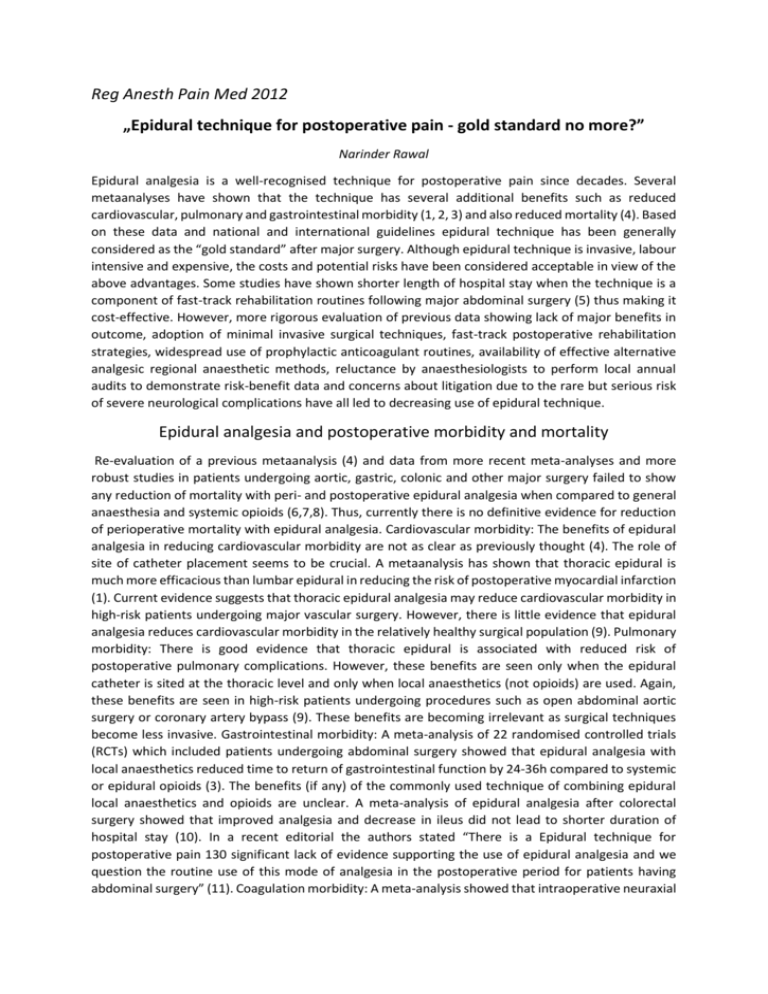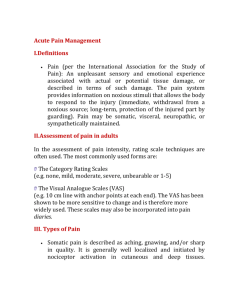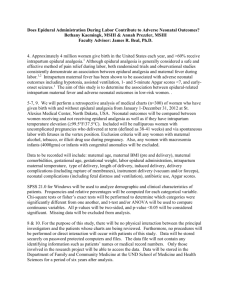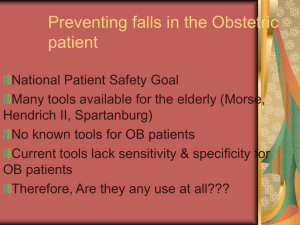Epidural technique for postoperative pain
advertisement

Reg Anesth Pain Med 2012 „Epidural technique for postoperative pain - gold standard no more?” Narinder Rawal Epidural analgesia is a well-recognised technique for postoperative pain since decades. Several metaanalyses have shown that the technique has several additional benefits such as reduced cardiovascular, pulmonary and gastrointestinal morbidity (1, 2, 3) and also reduced mortality (4). Based on these data and national and international guidelines epidural technique has been generally considered as the “gold standard” after major surgery. Although epidural technique is invasive, labour intensive and expensive, the costs and potential risks have been considered acceptable in view of the above advantages. Some studies have shown shorter length of hospital stay when the technique is a component of fast-track rehabilitation routines following major abdominal surgery (5) thus making it cost-effective. However, more rigorous evaluation of previous data showing lack of major benefits in outcome, adoption of minimal invasive surgical techniques, fast-track postoperative rehabilitation strategies, widespread use of prophylactic anticoagulant routines, availability of effective alternative analgesic regional anaesthetic methods, reluctance by anaesthesiologists to perform local annual audits to demonstrate risk-benefit data and concerns about litigation due to the rare but serious risk of severe neurological complications have all led to decreasing use of epidural technique. Epidural analgesia and postoperative morbidity and mortality Re-evaluation of a previous metaanalysis (4) and data from more recent meta-analyses and more robust studies in patients undergoing aortic, gastric, colonic and other major surgery failed to show any reduction of mortality with peri- and postoperative epidural analgesia when compared to general anaesthesia and systemic opioids (6,7,8). Thus, currently there is no definitive evidence for reduction of perioperative mortality with epidural analgesia. Cardiovascular morbidity: The benefits of epidural analgesia in reducing cardiovascular morbidity are not as clear as previously thought (4). The role of site of catheter placement seems to be crucial. A metaanalysis has shown that thoracic epidural is much more efficacious than lumbar epidural in reducing the risk of postoperative myocardial infarction (1). Current evidence suggests that thoracic epidural analgesia may reduce cardiovascular morbidity in high-risk patients undergoing major vascular surgery. However, there is little evidence that epidural analgesia reduces cardiovascular morbidity in the relatively healthy surgical population (9). Pulmonary morbidity: There is good evidence that thoracic epidural is associated with reduced risk of postoperative pulmonary complications. However, these benefits are seen only when the epidural catheter is sited at the thoracic level and only when local anaesthetics (not opioids) are used. Again, these benefits are seen in high-risk patients undergoing procedures such as open abdominal aortic surgery or coronary artery bypass (9). These benefits are becoming irrelevant as surgical techniques become less invasive. Gastrointestinal morbidity: A meta-analysis of 22 randomised controlled trials (RCTs) which included patients undergoing abdominal surgery showed that epidural analgesia with local anaesthetics reduced time to return of gastrointestinal function by 24-36h compared to systemic or epidural opioids (3). The benefits (if any) of the commonly used technique of combining epidural local anaesthetics and opioids are unclear. A meta-analysis of epidural analgesia after colorectal surgery showed that improved analgesia and decrease in ileus did not lead to shorter duration of hospital stay (10). In a recent editorial the authors stated “There is a Epidural technique for postoperative pain 130 significant lack of evidence supporting the use of epidural analgesia and we question the routine use of this mode of analgesia in the postoperative period for patients having abdominal surgery” (11). Coagulation morbidity: A meta-analysis showed that intraoperative neuraxial blocks (spinal, epidural) were associated with a reduction in deep venous thrombosis and pulmonary embolism (4). However, most of the studies in the meta - analysis were performed prior to the modern routines of using thromboprophylactic drugs and minimal invasive surgery. Thus, the influence of postoperative analgesia on coagulation-related outcomes is unclear. Patient satisfaction: In general, poor postoperative pain relief and analgesic-related side effects are associated with low levels of patient satisfaction. However, patient satisfaction as a primary outcome has been poorly studied. Thus, a systematic review showed that only 2 RCTs of 95 used a validated instrument for assessment of patient satisfaction. The authors of this review noted “Despite the theoretical benefits of superior analgesia, there is a lack of highquality data on the effect of different analgesic techniques and regimens on patient-reported outcomes such as health-related quality of life, quality of recovery, and patient satisfaction” (12). Length of hospital stay: Few studies have used prospectively defined discharge criteria for assessment of length of hospital stay. It has been stated that postoperative accelerated “multimodal” recovery programmes, in which epidural analgesia is a key component, decrease perioperative morbidity and reduce length of hospital stay (13). Risks of epidural technique: In a large study consisting of about 1.260.000 spinals and 450.000 epidurals, severe neurological complications were noted in 127 patients, out of these 85 suffered permanent neurological damage. The authors stated that the risks were greater than previously believed, they also identified elderly females as a high-risk group for these complications (14). A recent study from a 2 week national census in UK and which was based on data from 707.455 central neuraxial blocks showed that: “The data are reassuring and suggest that continual neuraxial blocade (CNB) has a low incidence of major complications, many of which resolve within 6 months” (15). The debate about how low is “acceptably low” is likely to continue, the risk-benefit ratio seems to be moving in favour of non-epidural techniques (16). A questionnaire survey of Australian consultant anaesthetists showed that 82% had changed their practice in recent years, they performed fewer epidural anaesthetics, the two most common reasons were fear of litigation and lack of evidence of beneficial effects (17). Alternatives to epidural analgesia It is emphasised that the benefits of epidural analgesia on cardiovascular, pulmonary and gastrointestinal morbidity have been reported in patients undergoing open and more invasive surgery. The recommendations for laparascopic procedures such as cholecystectomy and colonic surgery no longer include epidural technique (18). Furthermore, the above mentioned benefits of epidural analgesia were noted when compared to systemic opioids. Other, less invasive, local anaesthetic-based techniques such as perineural, intravenous, wound catheter infusions and high-volume local anaesthetic infusion (LIA) techniques may be as beneficial as epidural in appropriate surgical procedures. Current evidence is promising but there is a need for good comparative studies. It is also emphasised that inspite of the potential benefits of epidural technique including outstanding pain relief there is no evidence that the quality of analgesia (irrespective of the analgesic technique) has any effect on the length of hospital stay (8). There is increasing evidence from several meta-analyses and systematic reviews that good alternatives to epidural are now available for thoracic, abdominal and major orthopaedic surgery (19-26). These analgesic alternatives include paravertebral block for thoracotomy (19,20), peripheral nerve blocks for hip (21) and knee (22,23) replacement, i.v. lidocaine for Epidural technique for postoperative pain 131 colorectal surgery (24), wound catheter infusions (WCI) for a large variety of surgical procedures including abdominal, cardiothoracic, vascular and major abdominal (25) and transversus abdominis plane (TAP) block for surgery involving abdominal wall (26). Wound catheter infusions (WCI): This technique has been used to treat pain since many years after in-patient and ambulatory surgery (27). A systematic review of 39 RCTs including 15 RCTs of cardiothoracic surgery and 16 RCTs of major orthopaedic surgery showed that postoperative pain management by WCI was associated with decreased pain scores at rest and activity, decreased need for opioids, reduced incidence of postoperative nausea and vomiting, and increased patient satisfaction. The authors concluded “The most notable feature was the consistent evidence of these benefits across a wide range of surgical procedures, location of wound catheters, and dosing regimens accompanied by low incidences of catheter-related complications. Both the efficacy and technical simplicity of this technique encourage its widespread clinical use” (25). However, many questions remain to be addressed, these include: best position of catheter placement for different surgical procedures, local anaesthetic dose versus volume relationship, risk of local anaesthetic toxicity and possible role of adjuvants. The importance of appropriate catheter siting was shown in a study of patients undergoing open colorectal surgery. It was demonstrated that WCI through a catheter placed preperitoneally was associated with effective analgesia up to 72 h, reduced opioid consumption, early recovery of bowel function and shorter hospital stay by 30 h (28). Similarly, WCI with catheter placed subfascially provided as effective postoperative pain relief after C.section as that achieved by epidural technique (29). Intravenous lidocaine: A meta-analysis of 8 RCTs has shown that perioperative i.v. Lidocaine was associated with reduced duration of ileus, decreased pain scores, reduced opioid consumption, less nausea and vomiting and shorter length of hospital stay (24). Thus one of the main benefits of epidural technique i.e. early return of bowel function can be achieved by this simple technique. Transversus Abdominis Plane (TAP) Block Tranversus abdominis plane block is a relatively new technique that has shown promising results in the management of postoperative pain in patients undergoing major abdominal and gynaecologic surgery (R). Several modifications of the technique, with and without ultrasound guidance, have been reported. A recent review of published RCTs showed clinically significant reductions in opioid requirements and pain at rest and movement as well as reduction of opioid adverse effects such as sedation, nausea and vomiting (26). These benefits were demonstrated in patients undergoing various surgical procedures such as colon resection, C. section, abdominal hysterectomy, open appendectomy and laparoscopic cholecystectomy. The authors concluded “Post-operative pain treatment with TAP block is a promising new technique, demonstrating both a substantial reduction in morphine consumption as well as improved pain scores in surgery involving anterior abdominal wall” (26). There is a need for further studies to support the findings of what are still early results. High-volume local anaesthetic infiltration analgesia (LIA) technique: The LIA technique was introduced a few years ago by Kerr and Kohan for controlling postoperative pain after hip or knee arthroplasty as an integral component of their surgical approach (30). It is a 5-step process based on systematic infiltration of a mixture of ropivacaine combined with ketolorac and adrenaline. Using “moving needle” technique a large volume (up to 150 ml) of 0.2% ropivacaine is injected in the region subject to surgical trauma. A catheter is left in the joint for a single top-up at about 15-20 h postoperatively. Surgery is performed under spinal anaesthesia. In a study of 325 patients undergoing hip or knee arthroplasty the majority of patients had low pain scores and could be discharged after a single overnight stay. Mean time to independent mobility was less than 25 h for the entire cohort, and 20 h for patients undergoing TKR (30). The LIA technique has received much attention particularly in the Epidural technique for postoperative pain 132 Scandinavian countries. Several studies have been published showing impressive results and shorter hospitalisation times albeit longer than those reported by Kerr and Kohan (31-35). LIA was superior to epidural technique after total hip arthroplasty (31) and superior to femoral nerve block after total knee arthroplasty (34). Another recent study showed that LIA was better than epidural technique after the initial 24 h, patients had better knee function, were mobilised faster and were discharged 2 days earlier from the hospital (35). However, there are many questions that need to be addressed these include: role of local administration of ketolorac and adrenaline, role of compression and ice packing and the role of the surgical technique (36). Furthermore, there is a need to define what precisely is meant by LIA technique, today there are just about as many modifications of LIA as the number of practitioners of the technique thus making meaningful comparison of results difficult. As with any new technique further studies are necessary to establish the position of this promising technique in clinical practice. In conclusion, recent evidence suggests that the benefits of epidural technique are not as impressive as believed in the past. Although the efficacy of pain relief is outstanding and there might be some benefits in reduced cardiovascular and pulmonary morbidity in high-risk patients undergoing traditional major vascular or cardiac surgery, the indications for use of epidural technique are decreasing. The reasons for the decline of this invasive, high-cost, labour intensive technique are many: a) no evidence of decreased postoperative mortality, b) no convincing evidence of reduced risk of morbidity in the non high-risk surgical population, c) advances in surgical techniques such that many previous in-patient procedures are now day case or overnight stay surgery procedures, d) use of fast-track, epidural-free, early mobilisation postoperative rehabilitation routines, e) widespread implementation of prophylactic anticoagulant routines, f) increasing evidence that less invasive alternatives are as good or better than epidural after several types of major surgical procedures, g) hardly any evidence of costeffectiveness of epidural technique in spite of use for decades, h) risk of severe neurological complications is rare but discourages many clinicians because of litigation concerns. Thus, it is no exaggeration to say that the role of epidural is diminishing and this trend is expected to continue. Epidural technique is the gold standard for labour analgesia because there are no good alternatives. That cannot be said for the use of the technique after surgery. For routine postoperative analgesia epidural technique can no longer be considered the gold standard. (Adapted from Carl Koller lecture published in Reg Anesth Pain Med 2012 ) References 1. Beattie WS, Badner NH, Choi P. Epidural analgesia reduces postoperative myocardial infarction: a meta-analysis. Anesth Analg. 2001;93:853-8 2. Ballantyne JC, Carr DB, de Ferranti S et al. The comparative effects of postoperative analgesic therapies on pulmonary outcome:cumulative meta-analyses of randomized, controlled trials. Analg Anesth.1998;86:598-612 3. Jorgensen H, Wetterslev J, Moiniche S et al. Epidural local anaesthetics versus opioid-based analgesic regimens on postoperative gastrointestinal paralysis, PONV and pain after abdominal surgery. Cochrane database Syst Rev. 2000:CD001893. 4. Rodgers A, Walker N, Schug S et al. Reduction of postoperative mortality and morbidity with epidural or spinal anaesthesia: results from overview of randomized trials. BMJ 2000;321:1493 5. Kehlet H, Dahl J. Epidural analgesia and postoperative outcomes-a need for a different approach. Acta Anaesthesiol Scand 2008;52:1311-2 6. Rigg JR, Jamrozik K, Myles PS, et al. Epidural anaesthesia and analgesia and outcome of major surgery: a randomized trial. Lancet 2002;359:1276-1282 7. Park WY, Thompson JS, Lee KK. Effect of epidural anaesthesia and analgesia on perioperative outcome: a randomized,controlled Veterans Affairs cooperative study. Ann Surg 2001;234:560-9 8. Liu SS,Block BM, Wu CL. Effects of perioperative central neuraxial analgesia on outcome after coronary artery bypass surgery: a meta-analysis. Anesthesiology 2004;101:153-161Epidural technique for postoperative pain 133 9. Liu SS, Wu CL. Effect of postoperative analgesia on major postoperative complications:A systematic update of the evidence. Anesth Analg 2007;104:689-702. 10. Marret E, Remy C, Bonnet F. Meta-analysis of epidural analgesia versus parenteral opioid analgesia after colorectal surgery. Br J Surg 2007;94.665-73 11. Low J, Johnston N, Morris C. Epidural analgesia:first do no harm (editorial). Anaesthesia 2008;63:13 12. Liu SS, Wu CL. The effect of analgesic technique on postoperative patient-reported outcomes including analgesia: a systematic review. Anesth Analg 2007;105:789-808 13. Kehlet, Dahl JB. Anaesthesia, surgery, and challenges in postoperative recovery.Lancet 2003;362:1921-8 14. Moen V, Dahlgren N, Irestedt L. Severe neurological complications after central neuraxial blockades in Sweden 1990-1999. Anesthesiology 2004;101:950-9 15. Cook TM, Counsell D, Wildsmith JAW. Major complications of central neuraxial blocks:report on the third national audit project of the Royal College of Anaesthetists. Br J Anaesth 2009;102:179-90 16. Power GE, Warden B, Cooke K. Changing patterns in acute pain service:epidural versus patientcontrolled analgesia. Anaesth Intensive Care 2005;33:501-5 17. Chilvers CR, Nguyen MH, Robertson IK. Changing from epidural to multimodal analgesia for colorectal laparotomy: an audit. Anaesth Inrensive Care 2007;35: 230-8 18. Kehlet H, Gray AW, Bonnet F et al. A procedure-specific systematic review and consensus recommendations for postoperative analgesia following laparoscopic cholecystectomy. Surg Endosc 2005;19:396-415 19. Davies RG, Myles PS, Graham JM. A comparison of the analgesic efficacy and side-effects of paravertebral vs epidural blockade for thoracotomy-a systematic review and meta-analysis of randomized trials. Br J Anaesth 2006;96:418-26 20. Joshi GP, Bonnet F, Shah R et al. A systematic review ofrandomized trials evaluating regional techniques for postthoracotomy analgesia. Anesth Analg 2008;107:1026-40 21. Fischer HBJ, SimanskiCJP and PROSPECT working group. A procedure-specific systematic review and consensus recommendations for analgesia after hip replacement. Anaesthesia 2005;60:1189-1202 22. Fowler SJ, Symons J, Sabato S, Myles PS. Epidural analgesia compared with peripheral nerve blockade after major knee surgery: a systematic review and meta-analysis of randomized trials. Br J Anaesth 2008;100:154-64 23. Fischer HBJ,Simanski CJP, Sharp C et al. A procedure-specific systematic review and consensus recommendations for postoperative analgesia following total knee arthroplasty. 24. Anaesthesia 2008;63:1105-23 25. Marret E, Rolin M, Beaussier M, Bonnet F. Metaanalysis of intravenous lidocaine and postoperative recovery after abdominal surgery. Br J Surg 2008;95:1331-8 26. Liu SS, Richman JM, Thirlby RC, Wu CL. Efficacy of continuous wound catheters delivering local anesthetic for postoperative analgesia:a quantitative and qualitative systematic review of randomized controlled trials. J Am Coll Surg 2006;203:914-32 27. Petersen PL, Mathiesen O, Torup H, Dahl JB. The transversus abdominis plane block: a valuable option for postoperative analgesia) A topical review. Acta Anaesthesiol Scand 2010;54:529-35 28. Rawal N, Axelsson K, Hylander J et al. Postoperative patient-controlled local anesthetic administration at home. Anesth Analg 1998;86:86-9 29. Beaussier M, El Ayoubi H, Schiffer E et al. Continuous preperitoneal infusion of ropivacaine privides effective analgesia and accelerates recovery after colorectal surgery. A randomized, doubleblind,placebo-controlled study. Anesthesiology 2007:107:461-8 30. Ranta PO,Ala-Kokko TI, Kukkonen JE et al. Incisional and epidural analgesia after caesarean delivery: a prospective,placebo-controlled, randomized clinical study. Int J Obst Anesth 2006;15:189-94 31. Kerr DR, Kohan L. local infiltration analgesia: a technique for control of acute postoperative pain following knee and hip surgery: a case study of 325 patients. Acta Orthop 2008;79:174-83 32. Andersen KV, Pfeiffer-Jensen M, Haraldsted V, Söballe K. Reduced hospital stay and narcotic consumption, and improved mobilization with local and intraarticular infiltration after h ip arthroplasty:a randomized clinical trial of an intraarticular technique versus epidural infusion in 80 patients. Acta Orthop 2007;78:180-6Epidural technique for postoperative pain 134 33. Essving P, Axelsson K, Kjellberg J et al. Reduced hospital stay, morphine consumption, and pain intensity with local infiltration analgesia after unicompartmental knee arthroplasty. A randomized double-blind study of 40 patients. Acta Orthop 2009;80:213-9 34. Andersen LJ, Poulsen T, Krogh B, Nielsen T. Postoperative analgesia in total hip arthroplasty: a randomized double-blinded,placebo-controlled study on preoperative and postoperative ropivacaine, ketorolac, and adrenaline wound infiltration. Acta Ortop 2007;78:187-92 35. Toftdahl K, Nikolajsen L, Haraldsted V et al. Comparison of peri-and intraarticular analgesia with femoral nerve block after total knee arthroplasty: a randomized clinical trial. Acta Orthop 2007,78:1729 36. Spreng UJ, Dahl V, Hjall A et al. High volume local infiltration analgesia combined with intravenous or local ketolorac + morphine compared with epidural analgesia after total knee arthroplasty. Br J Anaesth 2010;105:675-82 37. Röstlund T, Kehlet H. High-dose local infiltration analgesia after hip and knee replacement- what is it, why does it work, and what are the future challenges? (editorial) Acta Orthop 2007;78:159- 61 38. Wu CL, Cohen SR, Richman JM et al. Efficacy of postoperative patient-controlled and continuous infusion epidural analgesia versus patient-controlled analgesia with opioids. A metaanalysis. Anesthesiology 2005;103:1079-88 39. Biki B, Mascha E, Moriarty DC et al. Anesthetic technique for radical prostatectomy surgery affects cancer recurrence. A retrospective analysis. Anesthesiology 2008;109:180-7 40. Yeager MP, Rosekranz KM.(Editorial) Cancer recurrence after surgery. A role for regional anesthesia? Reg Anesth Pain Med 2010;35:483-8 41. Chang CC, Lin HC, Lin HW, Lin HC. Anesthetic management and surgical site infections in total hip and knee replacement. A population-based study. Anaesthesiology 2010;113:279









